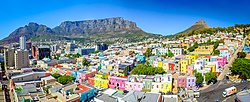
Back Bo-Kaap AF بو كيب Arabic বো-কাপ Bengali/Bangla Bo-Kaap Danish Bo-Kaap German Bo-Kaap Finnish Bo-Kaap French Bo-Kaap HA Բո-Կաապ HY Bo-Kaap ID
Bo-Kaap | |
|---|---|
 Bo-Kaap area of Cape Town with its distinctive pastel coloured houses in the foreground, with the city centre to the left and Table Mountain in the background | |
| Coordinates: 33°55′15″S 18°24′55″E / 33.92083°S 18.41528°E | |
| Country | South Africa |
| Province | Western Cape |
| Municipality | City of Cape Town |
| Established | 1760 |
| Area | |
• Total | 0.95 km2 (0.37 sq mi) |
| Population (2011)[1] | |
• Total | 3,203 |
| • Density | 3,400/km2 (8,700/sq mi) |
| Racial makeup (2011) | |
| • Coloured | 66.0% |
| • Black African | 9.0% |
| • White | 4.3% |
| • Indian/Asian | 3.4% |
| • Other | 17.3% |
| First languages (2011) | |
| • English | 64.0% |
| • Afrikaans | 30.3% |
| • Other | 5.7% |
| Time zone | UTC+2 (SAST) |
| Postal code (street) | 8001 |
| Area code | +27 (0)21 |
The Bo-Kaap (lit. "above the Cape" in Afrikaans) is an area of Cape Town, South Africa formerly known as the Malay Quarter. It is a former racially segregated area, situated on the slopes of Signal Hill above the city centre and is a historical centre of Cape Malay culture in Cape Town. The Nurul Islam Mosque, established in 1844, is located in the area.
Bo-Kaap is known for its brightly coloured homes and cobblestoned streets. The area is traditionally a multicultural neighbourhood, and 56.9% of its population identify as Muslim.[2] According to the South African Heritage Resources Agency, the area contains the largest concentration of pre-1850 architecture in South Africa, and is the oldest surviving residential neighborhood in Cape Town.[3]
- ^ a b c d "Sub Place Schotsche Kloof". Census 2011.
- ^ Kotze, Nico (2013). "A community in trouble?". Urbani Izziv. 24 (2): 124–132. doi:10.5379/urbani-izziv-en-2013-24-02-004. JSTOR 24920888.
- ^ Ishmail, S (2019-05-02). "Recognition for Bo-Kaap as 19 sites to be declared National Heritage Sites". IOL. Retrieved 2019-05-02.


